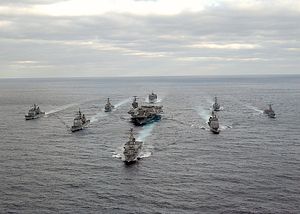Yesterday, USNI News reported that the Pentagon has dropped the name “Air Sea Battle” for its operational concept meant to counter the anti-access and area-denial (A2/AD) strategies of potential U.S. adversaries in future conflicts. According to an internal memo obtained by USNI News, the Air Sea Battle Office (ASBO) will be integrated into the Joint Staff J-7 Directorate (Joint Force Development), which will “monitor and support development of JAM-GC as required.” JAM-GC stands for “Joint Concept for Access and Maneuver in the Global Commons” and is the acronym replacing “Air Sea Battle.”
This revised concept, due out by the end of the year, will particularly try to integrate U.S. land forces into JAM-GC, something which had been lacking in the previous operational concept. The name Air Sea Battle (Nomen Est Omen!) emphasized the leading role of the U.S. Navy and Air Force in the development and execution of the Air Sea Battle, which caused some resentment among army strategists who felt left out in the development of counter-A2/AD strategies.
The Air Sea Battle concept was first publicly introduced in 2010 and has been controversial ever since. Although in public U.S. defense officials deny that this concept is aimed at a particular adversary or confined to a region, it is all too obvious that the principle adversaries in mind are China (in a Taiwan scenario) and Iran (in a Strait of Hormuz scenario). In plain terms, the concept wants to guarantee freedom of access in the global commons anywhere and in any domain (land, air, space, sea, and cyber) for the armed forces of the United States and its allies through improved joint forces integration and resource allocation.
It is important to note that this is still only a concept and not an official doctrine. A retired U.S. Air Force general summed up the difference in an article in back in 1984: “Whereas a concept is a hypothesis or an inference which suggests that a proposed pattern of behavior may possibly lead to a desired result, a doctrine is a generalization based on sufficient evidence to suggest that a given pattern of behavior will probably lead to the desired result.” Thus, a concept is merely the first step in developing a doctrine.
As Bernard D. Cole states in his book Asian Maritime Strategies – Navigating Troubled Waters, “ASB remained in 2013 very much a concept, with no written doctrine, proven technology, or demonstrated operational feasibility.” In addition, a senior U.S. Naval Officer, Rear Admiral James G. Foggo, III adds that it is no strategy: “An operational concept is a description of a method or scheme for employing military capabilities to attain specific objectives at the operational level of war. The overarching objective of the Air-Sea Battle Concept is to ‘gain and maintain freedom of action in the global commons.’ The Air-Sea Battle Concept is not a strategy.”
Nevertheless, the perception abroad has been that of an aggressive new strategy meant to guarantee U.S. dominance in all domains, which has hampered U.S. efforts to improve mil-to-mil relations with (for example) the People’s Liberation Army and PLA Navy. As I pointed out before, this perception is especially detrimental when it comes to Sino-U.S. cooperation in cyberspace. The new “Joint Concept for Access and Maneuver in the Global Commons” will in all likelihood not be very helpful in overcoming this impasse.

































